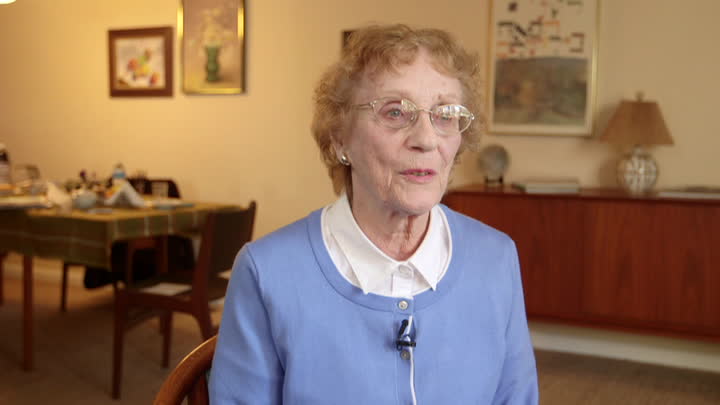In memory of Holocaust Survivor Anneliese Nossbaum

USC Shoah foundation is saddened to learn of the recent passing of Anneliese Nossbaum, who survived a Jewish ghetto and three concentration camps.
Anneliese passed away March 23, 2020 after falling ill within weeks of returning from a trip that commemorated the 75-year anniversary of the liberation of Auschwitz. She was 91.
She was born on January 8, 1929 in Guben, Germany as Anneliese Winterberg. At the age of two, her family moved to Bonn where her father later became the rabbi of their synagogue.
“I did not have a childhood without Nazi rule,” she remarked in her USC Shoah Foundation testimony taken in 1996. At 10 years old, Anneliese had progressively gotten used to living with German mandated public restrictions. The first time she truly felt impacted by the restrictions was when they banned Jewish people from movie theaters. Movies allowed her young mind the ability to escape from the rapidly growing tensions of reality. The loss of the movie house also symbolized her loss in any other form of normalcy. Shorty thereafter, Nazi officials mandated the addition of the Star of David on every Jewish person. “It was the first time I truly ever felt shame and a deep isolation,” she recounted.
In July 1941, the Nazis ordered her family—along with 400 other Jewish families—to be interned at the Jewish ghetto Theresienstadt. She stayed with her family in the Czech ghetto from July 1941 until October 1944.
Her last days in Theresienstadt were filled with sorrowful farewells to both her grandmothers and her father. All of the remaining working age men in the ghetto were deported to Auschwitz death camp days prior to her departure from Theresienstadt. Annalise would later find out that her father died after three months of internment at the death camp.
On October 5th, 1942 Anneliese, her mother, and her aunt were transferred to Auschwitz Birkenau. The journey was grueling, and by the time they arrived her mother had contracted tuberculosis. Upon arrival, her aunt was immediately sent to the gas chambers. “It was in that moment that I became mature. Most people have a gradual process to maturity, but that moment stripped of any remaining adolescence,” she said.
Realizing that she only had her mother left, at 15, Anneliese spent the next five days fighting not only for her life, but her mother’s as well. “A lot of people say it was only 5 days, but those five days ruined my life forever,” Nossbaum told the foundation. “Many people barely make it past one day in Auschwitz let alone five.”
On October 10, the Winterberg women were transferred to Freiburg concentration camp in Saxony, Germany. While there she was forced to work grueling hours as a metal wielder. She worked tirelessly for 10 hours a day, seven days a week in a small factory that packed 500 other women with her. The conditions of the camp were dire. In many cases, inmates were forced to choose between receiving food or using the toilet, often causing bouts of starvation.
After eight months in Freiburg, she was then transferred to Mauthausen concentration camp in Austria. The 16-day journey from Germany to Austria was harrowing. Captives were fed every third day, received very little bathroom breaks, and were enclosed in overcrowded cattle cars. On May 5th, 1945, days after their arrival to the camp, Anneliese and the remaining Holocaust survivors were liberated by the U.S. Army.
Her mother passed away December of that year due to tuberculosis-related complications. Orphaned and alone, Anneliese made her way to New York to stay with an aunt and uncle. By 18, she began attending evening school to obtain her diploma and started working a bookkeeping job that she would keep until her retirement.
Anneliese met her husband, Martin Nossbaum, through her evening school. As he went through similar situations in the Holocaust, the both of them bonded over dreams of starting anew. They settled down in Jenkintown, PA where they had two children Ivette and Jeffrey. Anneliese was an active member of her synagogue, singing in the choir and serving as a committee person for Holocaust memorials. She was also an avid lecturer for the Holocaust Awareness Museum where she spoke to thousands of high school and college aged students. She had an ardent passion for speaking to the youth and teaching younger generations about the importance of standing up against injustice. “I want young people to know that this can happen, and they should always speak up never stay quiet.”
She is survived by her two children and her four grandchildren. A true treasure and warrior, Anneliese will be greatly missed and forever in our memories.